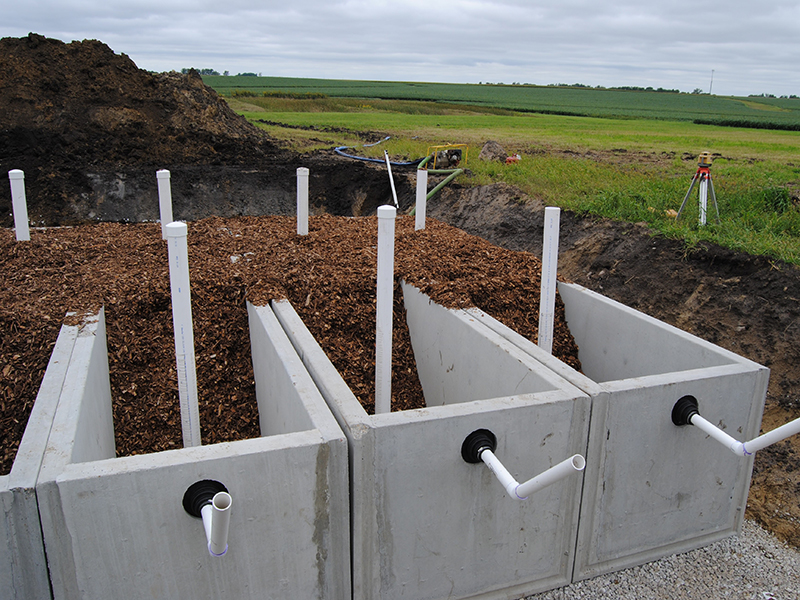This is huge. We have discussed the need for woodlot grooming from the very beginning. This naturally produces tons of woodchips. These can then be easily used to make paths in the woodlot as a default disposal,
More recent work showed us that a simple horizonal drum with a one third opening can be easily used to convert wood chips in particular to biochar. This is eassily quenched and mixed with earth or even sand and processed through a rotory screen in order to break it all down.. This can use a lot of hte available feed stock.
Now we discover that field drainage can be fed into a capture tank loaded with wood chips in order to grab the nitrogen fertyilizer that is running off. Obviously a bit tricky to impliment but it does mean that we do not have to abandon nitrogen fertizer completely to the river system.
June 16, 2021 - Bioreactors are underground trenches filled with woodchips. They have been gaining traction as a tool to remove nitrogen from the water in agricultural settings.
The water draining from fields is channeled into the bioreactors. Natural microbes living on the woodchips remove the nitrogen compounds in the water as it flows through.
Because it is the bacteria that do this water-cleaning process, it's called a biological process, hence the name bioreactor.
The water exiting the bioreactors has much less nitrogen, making it healthier for the environment.
In a new study, researchers tested parameters that could help estimate the working lifespan of these bioreactors. The research was published in Agrosystems, Geosciences & Environment, a publication of the American Society of Agronomy and Crop Science Society of America.
“Our goal is to give farmers and other stakeholders a better understanding of how long these systems will last when they are used in the field,” says Abby Schaefer, lead author of the study.
The study spanned two years. The researchers tested nine bioreactors. By the end of that time, all the bioreactors were still effectively removing nitrogen from the water.
Removing nitrogen from the drainage water in agricultural settings is crucial because nitrogen can be a double-edged sword.
Crops need nitrogen to grow and produce food. But too much nitrogen in the wrong place can cause problems.
Excess nitrogen can contaminate groundwater and waterways. In these aquatic environments, too much nitrogen can fuel harmful algal blooms.
The algae quickly use up all the oxygen in water bodies. This can lead to dead zones, which are areas with too little oxygen to support life.
Woodchip bioreactors are one way to reduce the amount of nitrogen entering waterways. The bioreactors have several advantages over other denitrifying techniques.
Bioreactors can consistently reduce 30-50% of nitrogen compounds from water. “Some bioreactors can achieve even higher reductions,” adds Schaefer.
“Bioreactors require very little land to be taken out of crop production,” says Schaefer. “Plus, they require very little maintenance.”
The bioreactors also do not impact the effectiveness of farm tile drainage systems. This means water in fields can still be drained to help prevent flooding.
One challenge with woodchip bioreactors is the settling and breakdown of the woodchips. This affects how efficiently the bioreactors work.
The researchers found that the woodchips closer to the entryway of the bioreactors settled and broke down faster than woodchips further inside.
That’s an important finding. Woodchips near the bioreactor inlets can be replenished without having to excavate the entire bioreactor.
Additionally, the researchers determined that the first three-quarters of the bioreactors was where most of the nitrogen compounds were removed from water.
That means replacing the woodchips near the entry point of a bioreactor could prolong the lifespan.
The team also studied the amount of time any given drop of water spends within the bioreactor. This measurement is called the hydraulic retention time.
“Hydraulic retention time is one of the main criteria for designing denitrifying bioreactors,” says Schaefer. “We wanted to understand the impact the retention time has on all facets of bioreactor performance.”
The researchers tested three different hydraulic retention times: 2 hours, 8 hours, and 16 hours. Most changes seen in the bioreactors over time were similar for the different retention times tested.
However, woodchips decomposed faster when the hydraulic retention time was 2 hours. But those bioreactors still removed nitrogen compounds from water effectively.
Schaefer and colleagues are now aiming to have a better understanding of how the bioreactors work over even longer periods of time.
Abby Schaefer is a researcher and engineer at Iowa State University. This work was supported by the Iowa Nutrient Research Center.
Photo Caption: Concrete linings are partially filled with woodchips during installation and monitoring wells are visible.
American Society of Agronomy, Soil Science Society of America, Crop Science Society of America: Collectively, these Societies represent more than 12,000 individual members around the world. Members are researchers and professionals in the areas of growing our world’s food supply while protecting our environment. Together we work toward solutions to advance scientific knowledge in the areas of agronomy, crop science, and soil science.

No comments:
Post a Comment